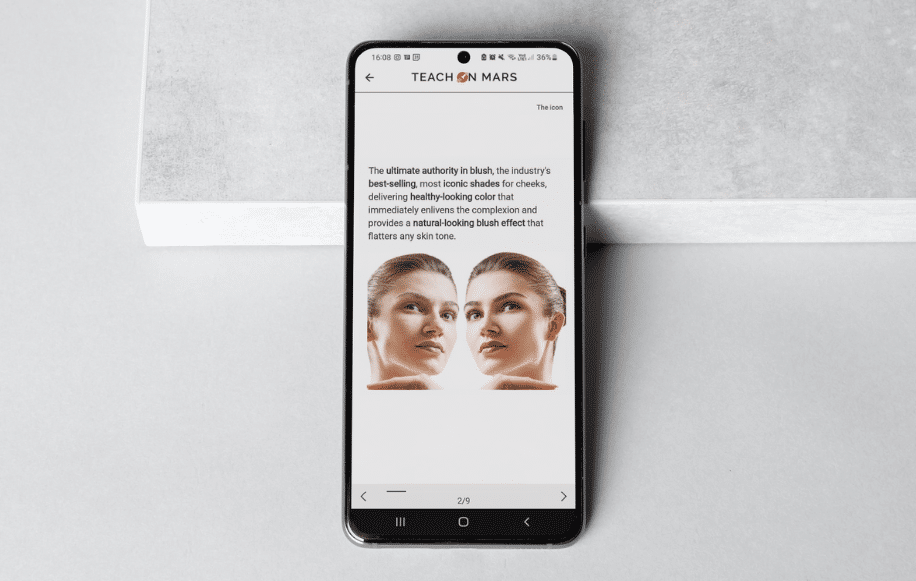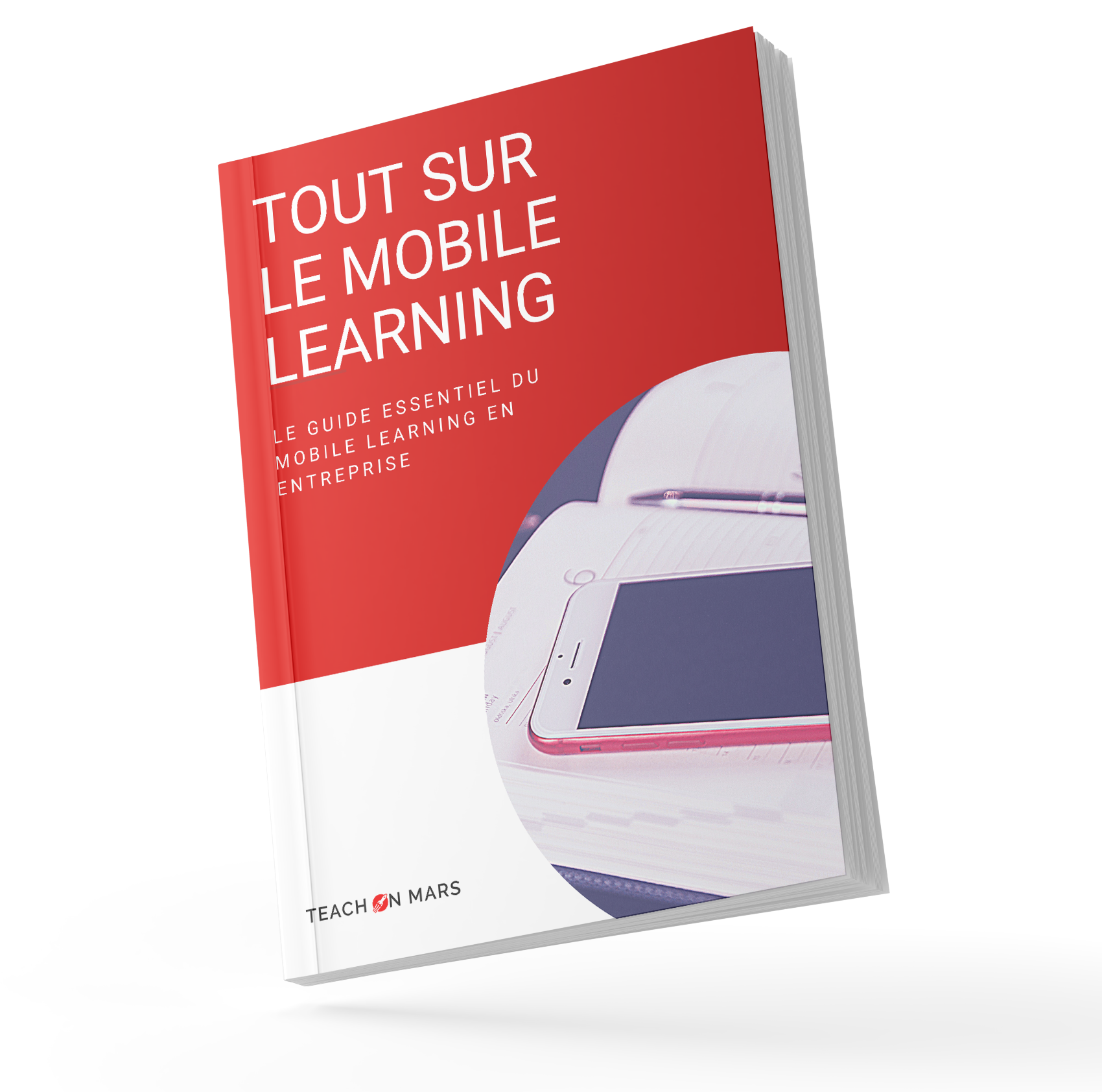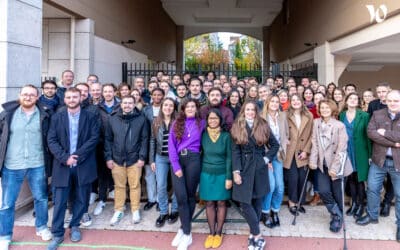Retail sector training implies a number of very specific constraints: disparity among populations, their mobility, competition among multi-brand distributors and turnover. Mobile learning and its entertaining features provide a tremendous opportunity to address these challenges. Let’s explore the ways gamification can help to captivate and retain salespeople and distributors.
Learning loops for better and faster learning
Content adapted to the sales rhythm: short, engaging and impactful
Mobile learning platforms represent a genuine opportunity for training teams managing a sales or distribution network. But the tool alone is not sufficient, courses must be adapted to the format to create a new kind of training.
By adjusting courses to the rhythm of your learners, mobile learning training helps attain unparalleled completion rates and unfailing loyalty.
The major point of interest in mobile learning is its mobility; learners can learn anywhere and anytime (ATADAWAC). You need to instil in them the desire to use their application to learn, and there’s nothing better than drawing inspiration from mobile games to reach this aim.
Producing content which is just as attractive as mobile games
Like a game of Candy Crush, 94% or 2048, your learning loop must be short, dynamic and engaging. The SISI model explains this clearly.
In this way, learner engagement comes more easily and naturally: learners don’t need to prepare for or “make an appointment” with their course. Once the short content has been completed, learners can move on to the next piece of content because other engagement drivers will have taken over (viable feedback, unblocking levels, etc.).
The operational orientation of your content should not be left out and the aim should be clear and achievable: discover product X and learn how to sell it.”
Your microlearning content lasts 2-5 minutes on average, it contains at least one top-down activity and one game activity and always ends with a link to a new piece of content. By meshing content, you let your learners’ serendipity run wild.

Bank on amusement to bring out the gamer in every salesperson
You might not know it but we all play each day, whether it’s a crossword, an Escape Game or by tracking the number of steps we take. Humans are naturally playful.
One of the best points about games is undoubtedly the motivation and interest players find through playing. How much satisfaction does amusement bring to someone’s life?
Understanding players to better reach salespeople
Richard Bartle, a neuroscience psychologist studied motivation levers in gamification and identified 4 main profiles.
• “Killers” love rankings: use them to make gamified courses more attractive.
• “Accumulators” want to win all the badges, to do so they are willing to repeat an activity several times.
• “Explorers” enjoy digital treasure hunts. Unblocking a module (subject to conditions) allows you to re-engage with them and to build loyalty.
• “Socialisers” meanwhile, prefer social challenges and are eager to publish photos and comments.
This is why m-learning content must include a multitude of triggers to fuel learner motivation: celebrations, communication forums, etc.
Bartle demonstrated that these edutainment levers are strong drivers of engagement. This can be seen in particular in the applications of our luxury and retail clients. Among populations with a strong commercial aspect, competitions and challenges are particularly strong driving forces in learners’ lives and help to create a culture of learning.
Build loyalty thanks to gaming world expertise
Using gamification is also a good way of rejuvenating traditional courses. There where traditional courses can sometimes suffer from limited diversification of modalities, gamification offers an infinite number of possibilities. By building on the entertaining aspects, training becomes more efficient: by competing against the clock, by being at the top of the rankings and by interacting with peers, your salespeople and distributors are part of a learner experience which places an onus on skills development while “having fun”.
Games also have a social component. They compensate for the fact that digital training is often done alone and remotely. The amusement factor (competitions, challenges, battles) brings training closer to people and relationships once again: it’s an excuse to create bonds and to find a source of enrichment while learning.

Standing out from the pack by providing an exceptional learner experience
Apart from the entertaining drivers, surprise plays an important role in building loyalty. Due to competition, offering an innovative and fluid learning experience is crucial if you wish to stand out. More importantly, it is also an opportunity to create a “wow” effect thanks to customisation, design, immersion, videos and visuals. Just like video games, whose graphics contribute greatly to the overall experience, even if they don’t necessarily have an educational aim.
Drawing inspiration from immersive learning to engage and build loyalty
Gamification is also about immersing players in a unique experience which enables you to reengage learners at every stage. Mihaly Csikszentmihalyi explains this clearly in his flow theory. He believes a state of fusion exists between players and their activity when the level is a perfect fit, when the fluidity of the experience is optimal and when learners are totally immersed in the game. Designers should therefore be aiming for flow in order to provide salespeople and distributors with an exceptional learning experience.
Inspired by immersive learning, Teach on Mars gamification lets you integrate 360-degree videos in augmented reality (VR): this enables salespeople to visit stores and workshops as though they were really there.
Do simulation activities enable us to place learners in situations to test their knowledge under almost-real conditions? Trainers recreate real situations in a “safe” setting in which the person can try things out, make mistakes and more importantly, try again.
Thanks to immersive content, stand out from competitors and make salespeople loyal to your products. This way, they will be more inspired to sell them.
New formats for ATADAWAC training
Une expérience d’apprentissage exceptionnelle c’est aussi apporter la formation dans le quotidien et lui permettre de trouver sa place.
La formation doit accompagner l’apprenant quand il est face au client grâce à des visuels de qualité et du contenu attractif et engageant. Il doit aussi l’accompagner dans l’arrière-boutique (le stock, par exemple) pour lui proposer, par exemple, un podcast qui lui permettra de se former sur un sujet de fond tout en ayant les mains libres. La gamification s’adapte alors au contexte pour venir valider les informations découvertes durant l’écoute.
Ce sont de nouveaux moments d’apprentissage qui enchantent le quotidien des vendeurs et des distributeurs car ils accompagnent leur montée en compétence de manière très concrète.
Engaging in form, building loyalty in substance
Exceptional learning experiences also provide day-to-day training that fits around schedules.
Training should support learners when they are speaking to customers thanks to high quality visuals and attractive and engaging content. It should also support them in the stock room for example and perhaps offer podcasts to help the person learn about a basic subject while their hands are free. Gamification can be suited to the context to validate the information discovered while listening.
These new learning activities are enhancing the daily lives of salespeople and distributors because they support their skills development in a very tangible manner.
Engaging in form, building loyalty in substance
A significant aspect of your course is marketing it! It is important to grasp how much a course’s form is just as important as its substance.
To this end, make use of good marketing practices (nudge, packaging, etc.): “calls-to-action” and communication drives to help learners to push open the door to learning. Visually attractive courses in total coherence with the product or the brand’s universe will boost memorisation.
Opt for visuals as a retention technique as part of entertaining activities. If you sell products, showcase them and create a universe around them. Tell a visual story to accompany the storytelling just like the product’s packaging does. Transmit the background idea to your salesperson; in this way they will sell the experience, as well as the product itself.
Discover our webinar, “Onboard your sales teams about new areas of performance”

D’abord éditrice de manuels scolaires, professeure et coordinatrice pédagogique à l’Université, Julia a rejoint l’équipe Learning Experience chez Teach on Mars pour apporter ses compétences en pédagogie. La gamification et la différenciation pédagogique sont notamment ses chevaux de bataille.





